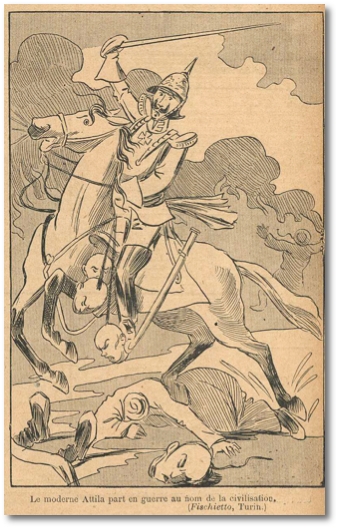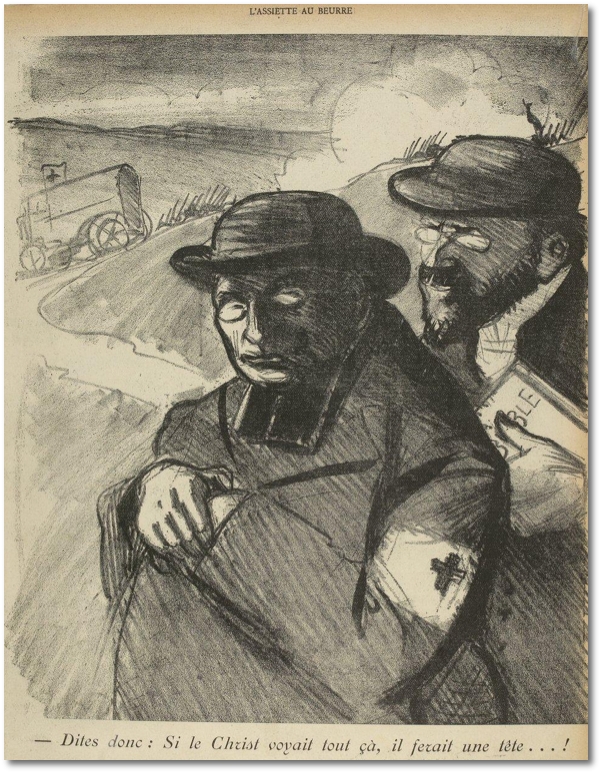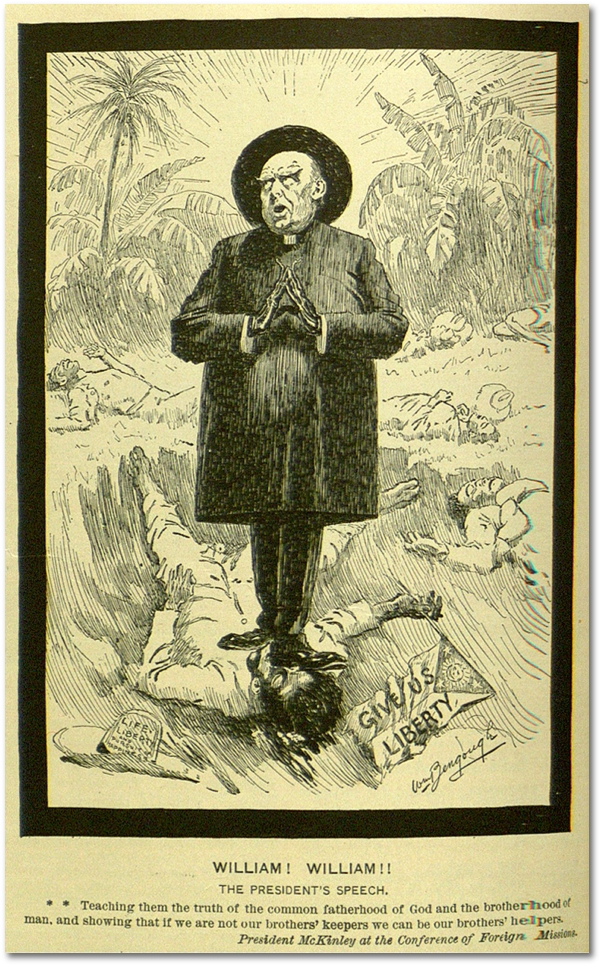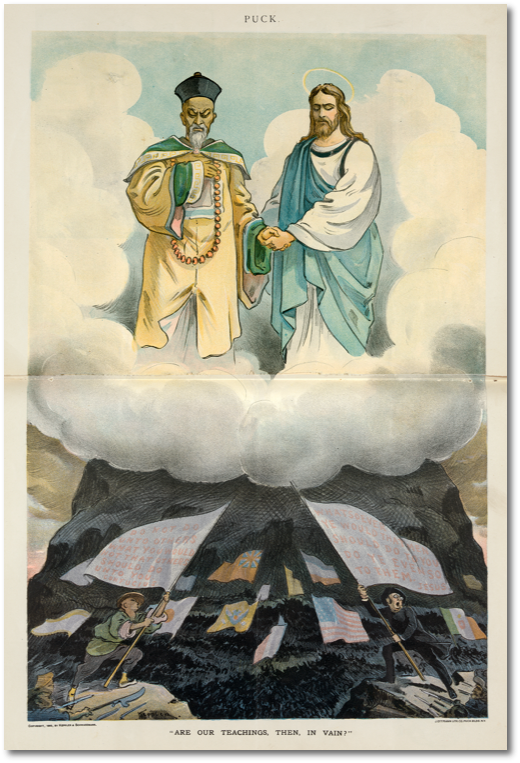| |
BIBLES & GUNS
“Advance Agent of Modern Civilization”: Religion & Empire
Religion played a major role in the characterization of others as heathens in need of salvation through education, conversion, and civilizing in the ways of Christian culture. The violence applied to these aims both in bodily harm and cultural ruin was only part of the hypocrisy. A number of critical cartoons of the time addressed the unsavory behavior of the “civilizers” themselves, and the disparity between doctrine and actions.
The synergy of piousness and power is the subject of a Keppler cartoon, “The Advance Agent of Modern Civilization,” in the January 12, 1898, issue of Puck. The divine right of kings—here, Wilhelm II, Emperor of Germany as a pompous war lord mounted on a colossal cannon—is intermingled with the divine mission of clergy, often the first Westerners allowed into foreign lands. The penetration of missionaries into the interior of China, for example, destabilized rural economies and incited anti-foreign sentiments. The cartoon links might with right, as the cannon is pushed and dragged forward by clergy identified by their headgear: skullcap, biretta, clerical hat, top hat, and distinctive English-style shovel hat. Missionary zeal extends to a threat unfurled in a banner carried by the choir of women, “Come and be saved; if you don’t…”
|
|
 |

 “The Advance Agent of Modern Civilization” “The Advance Agent of Modern Civilization”
Puck, January 12, 1898
Artist: Udo Keppler
Source: Library of Congress [view]
[cb40-029_1898_12January_puck_28770u]
In this detail, Germany’s Kaiser Wilhelm II appears as an anointed leader, his angel wings made of swords, astride a cannon dragged by clerics and missionaries toward foreign lands. Wilhelm points ahead, where the inhabitants flee. |
|
| |
In a post-Bismarck era, Germany was a late-comer to the colonial land grab in Africa and the Pacific. Its colonies were acquired through purchase, agreements with other world powers, and economic domination. However, brutally repressive policies followed that included accusations of genocide. Cartoonists portrayed Wilhelm II with increasing venom as a perpetrator of violence through World War I. He was just one of the imperial rulers and national figures to be demonized. As these cartoons reflect, the U.S., itself a new colonial power, was particularly threatened by the rise of Germany as a rival in the Pacific.
|
|
| |
“The Gospel According to St. William”
Puck, September 26, 1900
Artist: Udo Keppler
Source: Library of Congress [view]
[cb41-103_puck_1900_Sept26_StWilliam_25458u]
Puck’s caricature of Germany’s Bible-quoting Kaiser Wilhelm II ready to machine gun foreign non-believers captures the role of Christianity in turn-of-the-century Western imperialism.
|
|
| |
An Italian cartoonist who drew William II as a modern “Attila” beheading Chinese foes was likely inspired by his “Hun” speech to German soldiers shipping out to fight in the Boxer Uprising in China, delivered on July 27, 1900, in which he called for total war:
|
|
 
“Should you encounter the enemy, he will be defeated! No quarter will be given! Prisoners will not be taken! Whoever falls into your hands is forfeited. Just as a thousand years ago the Huns under their King Attila made a name for themselves, one that even today makes them seem mighty in history and legend, may the name German be affirmed by you in such a way in China that no Chinese will ever again dare to look cross-eyed at a German.”
|

|
“Le moderne Attila part en guerre
au nom de la civilisation.”
(The modern Attila goes to war
on behalf of civilization.)
Fischietto, ca. 1900
[cb42-011_dh7066_e1381_attila] |
|
“As the Heathen See Us”: Reversing the Gaze
Although usually associated with the pro-expansionist proponents of “civilization” and “progress,” Puck on occasion turned a discerning eye on the double standards of America’s so-called noble mission in the Philippines and China. Vignette-style graphics placed an array of smaller scenes around the central image. Several of these graphics from Puck commented on America’s problems at home while accusing “others” of being barbarians.
“Our ‘Civilized’ Heathen” asks what is civilized and who are the heathen. Ugly and shocking scenes of violence in 19th-century American life are ironically captioned as “refined and elegant” to challenge the self-image of a nation contributing cash “to save the heathen of foreign lands” while ignoring its own barbarity.
|
|
 |
|
“Our ‘Civilized’ Heathen.
And yet Uncle Sam is always giving money to ‘save the Heathen.’”
Puck, September 8, 1897
Artist: Samuel D. Ehrhart
Source: Library of Congress [view]
[cb43-104_puck_1897_Sept8_Heathen_28734u]
|
|
|
 Vignette captions (left panel): Vignette captions (left panel):
“The refined and elegant amusement of shooting live pigeons.”
“The noble sport of cock-fighting.”
“The manly art of bruising.”
|
 Vignette captions (right panel): Vignette captions (right panel):
“The elevating diversion of ‘turkey-grabbing’.”
“The admirable custom of ‘lynching’.” |
|
|
Raising money to “Save the Foreign Devils” recurs in the visual record. Cartoonist Victor Gillam turns the tables on American missionary zeal and moral imperative to “save the heathen” by showing how the Chinese might view the “foreign devils” in vignettes of ignorance, racism, and extreme violence in the United States.
|
|
 |
|
“As the Heathen See Us — A Meeting of the Chinese Foreign Missions Society.”
Signs: “Contributions received here to save the foreign devils”
and “Help the Heathen”
Puck, November 21, 1900
Artist: John S. Pughe
Source: Library of Congress [view]
[cb44-017_libc_1900_25475u]
Vignette caption (middle): "Burning Negros at the Stake"
|
|
|
 Vignette captions (left panel): Vignette captions (left panel):
"Kentucky feuds”
"New York City Government" |
 Vignette captions (right panel): Vignette captions (right panel):
"Labor riots"
"Anti-Chinese Riots" |
|
| |
The eight-nation military intervention during the Boxer Uprising in China in 1900 amounted to a global case study of how nations with superior technology wreaked violence abroad in the name of bringing about peace and civilization. In a run of 13 lithographs published in the July 4, 1900 issue of the French periodical L’Assiette au Beurre, the cartoonist René Georges Hermann-Paul was especially incisive in calling attention to this grim reality.
|
|
 |
| |
“— Dites donc: Si le Christ voyait tout ça, il ferait une tête ...!”
( I’d say: If Christ saw all this, he would lose his mind ...!)
L’Assiette au Buerre, No. 14, July 4, 1901
Artist: René Georges Hermann-Paul
Source: Bibliothèque nationale de France
[cb50-230_1901_July4_231]
In this French cartoon from a special issue titled, “La Guerre” (War), a missionary and a Red Cross representative lament the violent and un-Christian behavior of Westerners overseas.
|
|
| |
The anti-imperialist Life magazine was similarly attuned to the hypocrisy of cloaking military violence in pious rhetoric. In May 1900, for example, artist William Bengough scathingly debunked a speech by President McKinley—once again justifying the U.S. actions in taking of the Philippines by force—by depicting him as a parson standing on the face of a dead Filipino. The small print under this graphic quoted these lines from McKinley’s speech: “Teaching them the truth of the common fatherhood of God and the brotherhood of man, and showing that if we are not our brothers’ keepers we can be our brothers’ helpers.”
|
|
 |
| |
“William! William!! The President’s Speech”
Life, May 24, 1900
Artist: William Bengough
Source: Widener Library, Harvard University
[cb93-317_1900_May24_life1900v2_013]
U.S. President William McKinley is depicted as a preacher standing on a dead Filipino, grinding his heel into the man’s face. The caption quotes one of the president’s speeches: “Teaching them the truth of the common fatherhood of God and the brotherhood of man, and showing that if we are not our brothers’ keepers we can be our brothers’ helpers. — President McKinley at the Conference of Foreign Missions.”
The fallen man clasps the flag of the Philippine independence movement, inscribed with the words “Give Us Liberty.” His hat quotes the most famous phrase in the U.S. Declaration of Independence:“Life, liberty, and the pursuit of happiness.”
|
|
| |
The following year, Life cartoonist William H. Walker evoked the horror of the Allied intervention in China in a graphic captioned, “Almost thou persuadest me to be a Christian—Acts xxvi, 28.” A Chinese man falls off his chair, the Bible at his feet, laughing at Uncle Sam’s duplicity in preaching Christianity while showing a bloody panorama of Allied soldiers executing and marauding on a screen.
The screen in the cartoon may refer to the early films that fed public fascination with China and the Boxer crisis, including Edison’s recreation of the “Bombardment of Taku Forts by the Allied Fleets” (1900, view in the Library of Congress) and a four-minute British production that staged the murder of a missionary by Boxers called “Attack on a China Mission” (1900). The Life cartoon takes a different view of the barbarism in these events, focussing on Allied brutality against the Chinese. The caption refers to a Bible passage in which belief is nearly, but not completely reached.
|
|
 |
|
“Almost thou persuadest me to be a Christian
—Acts xxvi, 28.”
Life, April 25, 1901
Artist: William H. Walker
Source: Widener Library, Harvard University
[cb97-321_1901_life1901v1_020_widener]
In this mocking Life cartoon, a Chinese man with an overturned Bible at his feet laughs ironically at how both the Bible and Uncle Sam relish scenes of slaughter. The 1901 date indicates that the specific reference is to Allied reprisals against Chinese civilians following the Boxer Uprising.
|
|
| |
“Are our teachings, then, in vain?" is the caption of a cartoon by Puck’s Udo Keppler in which Confucius and Jesus Christ look down on the warring Boxers and missionaries. Boxers practiced spirit-possession rituals, often meeting in Buddhist temples, and attacked Christian missionaries and Chinese converts. Missionaries preaching the Gospel in rural China violated local religious practices. The enlarged detail below reveals that the flags of the opponents say the same thing in different words, each justifying their wars to uphold the principle of the “Golden Rule.”
|
|
 |
|
“Are our teachings, then, in vain?"
Puck, October 3, 1900
Artist: Udo Keppler
U.S. Library of Congress
[view]
[cb53-005_1900_PUCK_Oct3_Jesus_25461u_lc]
This rueful cartoon places Confucius and Jesus side-by-side and laments the failure of all parties to practice what they preach. The banners of both side pronounce fidelity to the “golden rule.”
|
|
 |
|
 Boxer banner (Chinese forces flags): “Do not do unto others what you would not that others should do unto you. Confucius” Boxer banner (Chinese forces flags): “Do not do unto others what you would not that others should do unto you. Confucius”
|
 Missionary banner (Allied forces flags): “Whatsoever ye would that men should do to you do ye even so to them. Jesus” Missionary banner (Allied forces flags): “Whatsoever ye would that men should do to you do ye even so to them. Jesus” |
|
|





